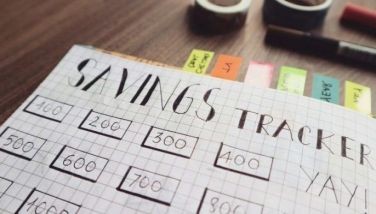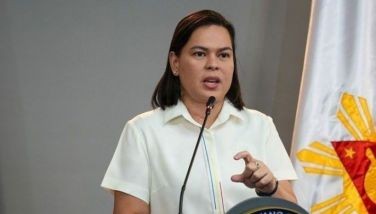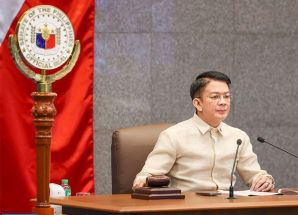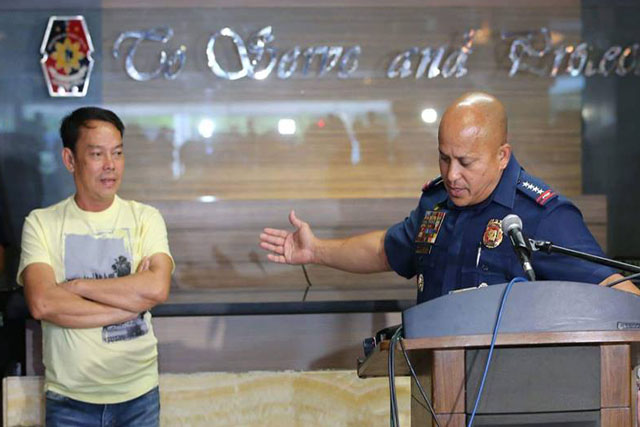Toy Library
March 24, 2002 | 12:00am
What? Toys in school?
Yes, and there’s even a teacher assigned to the class...ah, toy room.
One afternoon at the Betty Go Belmonte Elementary School in Quezon City, we chance upon a room full of kids between six and seven years of age who are busy playing.
The kids are left on their own to decide what to play with and whom to play with. They seem to prefer games which they can play in groups rather than going solo. A teacher watches over them, but she chooses to stay in the background and will intervene only if an argument or quarrel arises. Today there are no arguments–only children’s laughter fills the room.
There are all sorts of toys scattered around–plastic toys which are of the educational type, board games like dominos and Scrabble, stuffed toys, a TV set and even a computer. Although there are many choices to make, quite a few kids go for the miniature billiard tables and decide among themselves who gets first shot at the game.
"Children who live in the poorer areas of our society do not get the chance to play with toys. All they normally have are sticks and old cans," says Dr. Edna Azurin, president of the Organization Mondiale pour l’Education Prescloaire (omep) who has set up toy libraries in 25 public elementary schools in Quezon City.
Dr. Azurin says that the concept of a toy library is nothing new. Matter of fact, she shares that there have been toy libraries in the Scandinavian countries even in the 1930s. The US picked up the concept and started its own libraries in the 1960s.
But here in the Philippines, in Quezon City in particular, the concept is just beginning to pick up speed. The need for such libraries is a must as far as Dr. Azurin and Mrs. Darna C. Dimaya, principal at the Betty Go Belmonte Elementary School, are concerned, because home for children from poorer families does not always mean rest and play, but more work. Working children especially have no time to be kids, so the toy library represents an effort to ensure that they have a kid-friendly refuge to experience.
"It is only here at school that most of our pupils are able to play. When they go home they either have to do chores or some of them end up having to sell sampaguita leis on Araneta Avenue which is near the school," reveals Ms. Dimaya.
"The United Nations Convention on the Rights of the Child explicitly states that every child has the right to leisure, play and to participate in cultural and artistic activities," says Dr. Azurin. And this is why she feels that setting up a toy library in public schools is a must. After all, she points out that it is through play that a child learns new concepts and develops his or her ability to interact with other children. All of this is learned and absorbed at a young age.
The toy library concept works much like a book library. The only difference is that the children are not allowed to take the toys home, although both Dr. Azurin and Ms. Dimaya wish they could allow them to do so. "But it is hard because if a child were to take home a toy, he would have to share it with his siblings and we are afraid that if there is an epidemic in their home all the other kids who will play with the toys later on could catch the illness," says Ms. Dimaya.
Although the original concept of the toy library was to help in the development of children between the ages 0 to 8, Dr. Azurin points out that in the public schools even children up to grades four and five are allowed use of the toy library.
"We have scheduled chalkless days for our pupils," says Ms. Dimaya. "Each grade level has a day of the week where the teacher does not use the blackboard. During this day, the children have their classes outside the classroom where they tell stories or they come and use the toy library."
Dr. Azurin says that in the past, the public school system did not have kindergarten. But today this is no longer so. "We started offering free kinder classes. But today, the Department of Education has allowed public schools to offer kinder classes where parents are asked to pay a minimum fee of P100 per month so that they can give an honorarium to the volunteer teacher of the class," says Dr. Azurin.
At the start, it was these pre-school pupils who were supposed to be the main beneficiaries of the toy libraries. "But here in our school we cannot limit the use of the toy libraries only to the little ones. The older children must also be able to play with the toys," says Ms. Dimaya, who points out that the total enrollment in their school is 1,952.
Neither rain nor flood can stop access to the toy library, Ms. Dimaya says. "We have had to relocate the toy library to the second floor of the school because flooding is a big problem here," she explains. Ms. Dimaya says the toys are safe on the second floor so that even if it rains the children can still play during their toy library day.
Dr. Azurin says that they try to fill the library with toys that are not only educational but also those that allow the kids some exercise. "We have balls and skipping rope for those who want to play and perspire. But we also accept broken clocks and watches and we allow the children to disassemble them so that they can learn how the clock works," says Dr. Azurin.
Azurin says that toys are useless unless children can play with them, keeping in mind the Filipino habit of keeping the good toys locked away as decorative pieces in their homes. "It is not hard to get our toys fixed. If one of the stuffed dolls break, then we can ask the home economics teacher or even the parents to help us mend the toy. The carpentry shop comes in handy when the other toys start to fall apart," says Dr. Azurin matter-of-factly. But for her, it is better if the toys which are given to the toy libraries are of the sturdy kind so that "they can last a long time".
Since Dr. Azurin is on top of the toy library concept, she says that in other public schools in Quezon City where there is more space and no flooding, they have been able to set up sand boxes and monkey bars. "A playground is very important in a child’s growing years. We might take all this for granted, but for the children from poorer families these little things are already big luxuries as far as they are concerned," Dr. Azurin adds.
"Many of the toys we have at our toy libraries come from donations of people who want to help our public schools," says Dr. Azurin. "But we refuse to accept toys that in one way or another have something to do with violence. This means guns and similar toys are not accepted in our libraries. The children see too much violence on TV. Here in school we want them to learn to be peace-loving," adds Ms. Dimaya.
It is the desire of Dr. Azurin to help the public schools move away from being too structured in their approach to educating a child. "Too often the school curriculum is too structured so that the children have no more time for play. If we give our children the opportunity to develop in a healthy atmosphere of spontaneity and creativity, I believe they will become more responsible and productive citizens in the future," Dr. Azurin says.
Share your toys with the Toy Library project through the Quezon City chapter of the Girl Scouts of the Philippines.
Yes, and there’s even a teacher assigned to the class...ah, toy room.
One afternoon at the Betty Go Belmonte Elementary School in Quezon City, we chance upon a room full of kids between six and seven years of age who are busy playing.
The kids are left on their own to decide what to play with and whom to play with. They seem to prefer games which they can play in groups rather than going solo. A teacher watches over them, but she chooses to stay in the background and will intervene only if an argument or quarrel arises. Today there are no arguments–only children’s laughter fills the room.
There are all sorts of toys scattered around–plastic toys which are of the educational type, board games like dominos and Scrabble, stuffed toys, a TV set and even a computer. Although there are many choices to make, quite a few kids go for the miniature billiard tables and decide among themselves who gets first shot at the game.
"Children who live in the poorer areas of our society do not get the chance to play with toys. All they normally have are sticks and old cans," says Dr. Edna Azurin, president of the Organization Mondiale pour l’Education Prescloaire (omep) who has set up toy libraries in 25 public elementary schools in Quezon City.
Dr. Azurin says that the concept of a toy library is nothing new. Matter of fact, she shares that there have been toy libraries in the Scandinavian countries even in the 1930s. The US picked up the concept and started its own libraries in the 1960s.
But here in the Philippines, in Quezon City in particular, the concept is just beginning to pick up speed. The need for such libraries is a must as far as Dr. Azurin and Mrs. Darna C. Dimaya, principal at the Betty Go Belmonte Elementary School, are concerned, because home for children from poorer families does not always mean rest and play, but more work. Working children especially have no time to be kids, so the toy library represents an effort to ensure that they have a kid-friendly refuge to experience.
"It is only here at school that most of our pupils are able to play. When they go home they either have to do chores or some of them end up having to sell sampaguita leis on Araneta Avenue which is near the school," reveals Ms. Dimaya.
The toy library concept works much like a book library. The only difference is that the children are not allowed to take the toys home, although both Dr. Azurin and Ms. Dimaya wish they could allow them to do so. "But it is hard because if a child were to take home a toy, he would have to share it with his siblings and we are afraid that if there is an epidemic in their home all the other kids who will play with the toys later on could catch the illness," says Ms. Dimaya.
Although the original concept of the toy library was to help in the development of children between the ages 0 to 8, Dr. Azurin points out that in the public schools even children up to grades four and five are allowed use of the toy library.
"We have scheduled chalkless days for our pupils," says Ms. Dimaya. "Each grade level has a day of the week where the teacher does not use the blackboard. During this day, the children have their classes outside the classroom where they tell stories or they come and use the toy library."
Dr. Azurin says that in the past, the public school system did not have kindergarten. But today this is no longer so. "We started offering free kinder classes. But today, the Department of Education has allowed public schools to offer kinder classes where parents are asked to pay a minimum fee of P100 per month so that they can give an honorarium to the volunteer teacher of the class," says Dr. Azurin.
At the start, it was these pre-school pupils who were supposed to be the main beneficiaries of the toy libraries. "But here in our school we cannot limit the use of the toy libraries only to the little ones. The older children must also be able to play with the toys," says Ms. Dimaya, who points out that the total enrollment in their school is 1,952.
Neither rain nor flood can stop access to the toy library, Ms. Dimaya says. "We have had to relocate the toy library to the second floor of the school because flooding is a big problem here," she explains. Ms. Dimaya says the toys are safe on the second floor so that even if it rains the children can still play during their toy library day.
Dr. Azurin says that they try to fill the library with toys that are not only educational but also those that allow the kids some exercise. "We have balls and skipping rope for those who want to play and perspire. But we also accept broken clocks and watches and we allow the children to disassemble them so that they can learn how the clock works," says Dr. Azurin.
Azurin says that toys are useless unless children can play with them, keeping in mind the Filipino habit of keeping the good toys locked away as decorative pieces in their homes. "It is not hard to get our toys fixed. If one of the stuffed dolls break, then we can ask the home economics teacher or even the parents to help us mend the toy. The carpentry shop comes in handy when the other toys start to fall apart," says Dr. Azurin matter-of-factly. But for her, it is better if the toys which are given to the toy libraries are of the sturdy kind so that "they can last a long time".
"Many of the toys we have at our toy libraries come from donations of people who want to help our public schools," says Dr. Azurin. "But we refuse to accept toys that in one way or another have something to do with violence. This means guns and similar toys are not accepted in our libraries. The children see too much violence on TV. Here in school we want them to learn to be peace-loving," adds Ms. Dimaya.
It is the desire of Dr. Azurin to help the public schools move away from being too structured in their approach to educating a child. "Too often the school curriculum is too structured so that the children have no more time for play. If we give our children the opportunity to develop in a healthy atmosphere of spontaneity and creativity, I believe they will become more responsible and productive citizens in the future," Dr. Azurin says.
Share your toys with the Toy Library project through the Quezon City chapter of the Girl Scouts of the Philippines.
BrandSpace Articles
<
>
- Latest
- Trending
Trending
Latest
Trending
Latest
Recommended



















